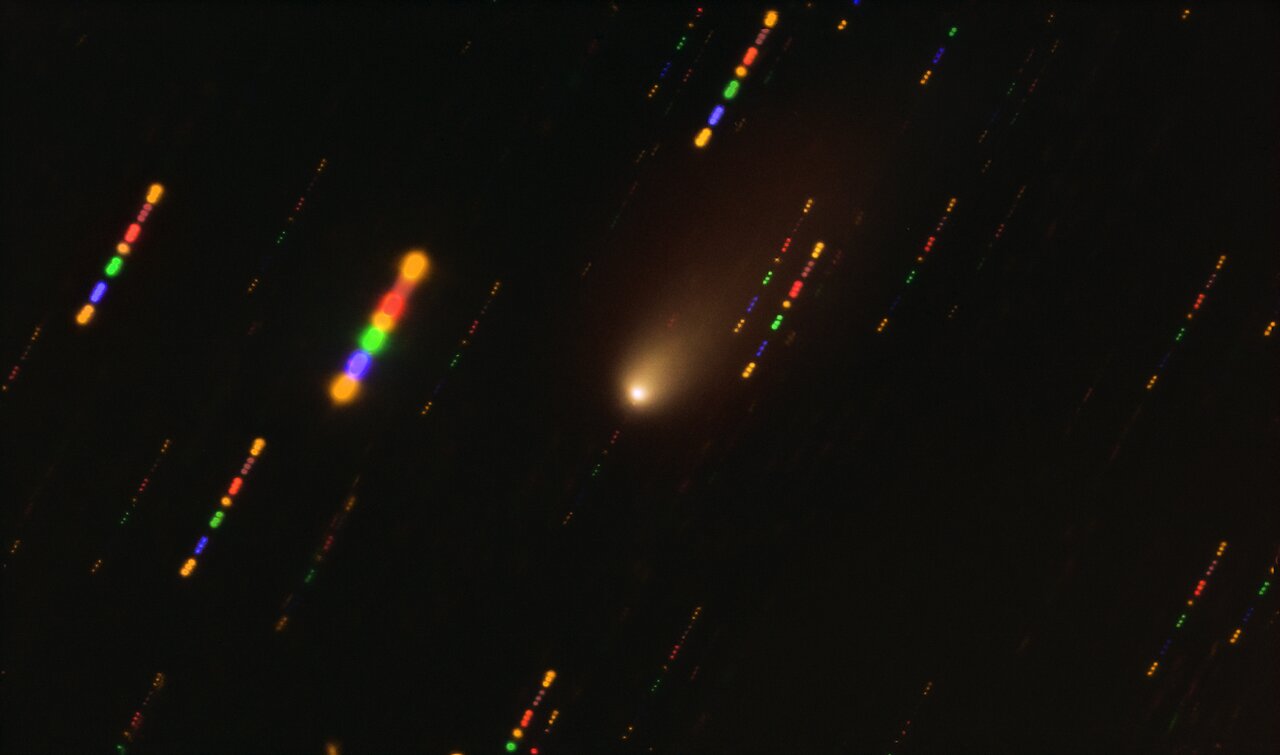

This image was taken with the FORS2 instrument on ESO’s Very Large Telescope in late 2019, when comet 2I/Borisov passed near the Sun. Since the comet was travelling at breakneck speed, around 175 000 kilometres per hour, the background stars appeared as streaks of light as the telescope followed the comet’s trajectory. The colours in these streaks give the image some disco flair and are the result of combining observations in different wavelength bands, highlighted by the various colours in this composite image.
By comparing our local Comet Hale-Bopp to the interstellar visitor 2I/Borisov, a team of astronomers have concluded that the interloper is perhaps one of the most pristine comets we’ve ever seen.
“2I/Borisov could represent the first truly pristine comet ever observed,” says Stefano Bagnulo of the Armagh Observatory and Planetarium, Northern Ireland, UK, who led the new study published recently in Nature Communications.
Many comets pass at least once through the inner solar system in their lifetimes. When they do, they encounter the solar wind and any other random pieces of microscopic junk floating around. This contaminates them to such a degree that astronomers can determine how many passages a comet has made since it formed.
Comet Hale-Bopp, which wowed stargazers in the late 1990’s, was amazingly pure. Astronomers estimated that prior to its entry in the late 20th century, it had only passed close to the sun once before.
Using the FORS2 instrument at the European Southern Observatory’s Very Large Telescope in Chile, a team of astronomers carefully studied the interstellar comet 2I/Borisov. That visitor was discovered by amateur astronomer Gennady Borisov in August 2019, and was the second known interstellar interloper to our solar system. The research team found that Borisov and Hale-Bopp were remarkably similar.
“The fact that the two comets are remarkably similar suggests that the environment in which 2I/Borisov originated is not so different in composition from the environment in the early Solar System,” says Alberto Cellino, a co-author of the study, from the Astrophysical Observatory of Torino, National Institute for Astrophysics (INAF), Italy.
Olivier Hainaut, an astronomer at ESO in Germany who studies comets and other near-Earth objects but was not involved in this new study, agrees. “The main result — that 2I/Borisov is not like any other comet except Hale–Bopp — is very strong,” he says, adding that “it is very plausible they formed in very similar conditions.”
2I/Borisov may not have ever passed close to its parent star before getting ejected into interstellar space and making its way to our own solar system.
“The arrival of 2I/Borisov from interstellar space represented the first opportunity to study the composition of a comet from another planetary system and check if the material that comes from this comet is somehow different from our native variety,” explains Ludmilla Kolokolova, of the University of Maryland in the US, who was involved in the Nature Communications research.
The truth is, we don’t know much about the lives of comets, especially interstellar ones. But future missions may help paint a fuller picture.
Bagnulo hopes astronomers will have another, even better, opportunity to study a rogue comet in detail before the end of the decade. “ESA is planning to launch Comet Interceptor in 2029, which will have the capability of reaching another visiting interstellar object, if one on a suitable trajectory is discovered,” he says, referring to an upcoming mission by the European Space Agency.
Well that’s ruined all my lectures! I’ve spent years talking about space and a go…
According to Darwin, life on Earth may have first appeared in warm little ponds. This…
The habitable zone is where planets could have liquid water on their surfaces, but not…
Air travel produces around 2.5% of all global CO2 emissions, and despite decades of effort…
Researchers study enigmatic asteroid Kamo'oalewa, as China’s first asteroid sample return mission moves toward launch.…
In 2007, astronomers discovered the Cosmic Horseshoe, a gravitationally lensed system of galaxies about five-and-a-half…